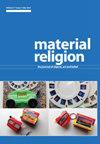Paper Icons and Fasting Bodies: The Esthetic Formations of Serbian Orthodoxy
IF 0.4
3区 哲学
0 RELIGION
引用次数: 4
Abstract
Abstract Drawing on ethnographic data from central Serbia, the article uses the concept of “esthetic formations” to consider how divergent expressions of Orthodox Christianity intersect in postsocialist space. The majority of Serbs identify as “Orthodox” and Orthodox imagery pervades the public sphere—but only a minority engage concertedly with liturgical practice. Through their regular fasting and churchgoing such self-identifying “believers” embody an Orthodox esthetic which is at once connected to—and yet distinct from—the overarching Orthodox cultural context. Whilst for churchgoers such embodiment represents sincerity and commitment, for many others it represents fanaticism and excessive piety. Overall, the article makes two claims. First, that “esthetic formations” are not internally rigid and that esthetics can divide as much as they unite. Second, that embodied esthetics allow different actors to articulate different moral claims about what constitutes sincere Orthodox practice.纸的图标与禁食的身体:塞尔维亚东正教的美学形态
摘要本文借鉴塞尔维亚中部的民族志资料,运用“审美形态”的概念来思考东正教的不同表达在后社会主义空间中是如何交叉的。大多数塞尔维亚人认为自己是“东正教”,东正教的形象充斥着公共领域,但只有少数人参与了礼拜仪式。通过定期禁食和去教堂,这些自我认同的“信徒”体现了一种东正教美学,这种美学既与总体的东正教文化背景有关,又与之不同。虽然对教徒来说,这种化身代表着真诚和承诺,但对许多其他人来说,它代表着狂热和过度虔诚。总的来说,这篇文章提出了两个主张。首先,“审美形态”不是内在僵化的,美学可以分裂,也可以团结。其次,这种具体化的美学允许不同的行动者就什么是真诚的东正教实践表达不同的道德主张。
本文章由计算机程序翻译,如有差异,请以英文原文为准。
求助全文
约1分钟内获得全文
求助全文

 求助内容:
求助内容: 应助结果提醒方式:
应助结果提醒方式:


